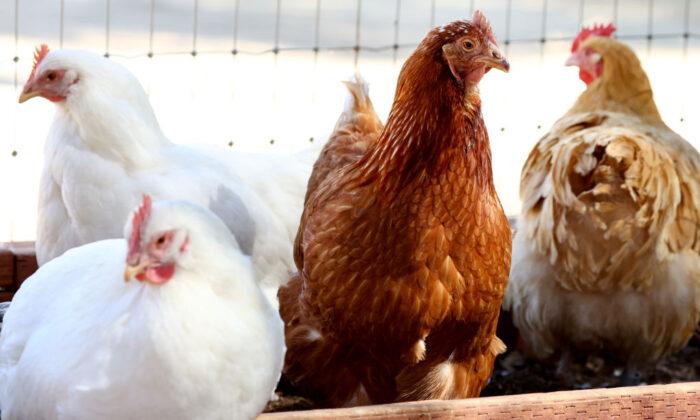HARRISBURG, Pennsylvania—The public’s pocketbooks have been hit hard by the skyrocketing cost of eggs in the last few months. Prices have doubled and, in some places, tripled over what they cost a year ago—if you can even find them in your local grocery store.
The average cost of a dozen eggs in the United States is over $4.25, more than twice what it was just a year ago. Options such as cage-free eggs or organic go for over $7. Inflation is a part of the reason, but the agriculture industry says the bigger cause is the outbreak of the avian flu here in the United States a year ago; nationwide, it has affected nearly 60 million birds—nearly 5 million of them here in Pennsylvania.
American consumers love their eggs. The food staple is highly regarded by every walk of life for its simplicity and accessibility; for some families, it is their major source of protein. For others, it is the most important ingredient in baking and the central element in preparing casseroles, pasta, and numerous other dishes.
For many of us, it is hard to make a meal without an egg, so of course consumers are deeply affected by this. However, there is another side of that story that we are not examining. That is the equally devastating economic impact this is having on American poultry farmers and all of those who work with them. Their lives, livelihoods, and family legacies have been upended and even destroyed by the avian flu, a worldwide outbreak that shows no signs of subsiding.
Stopping the spread of avian flu is like chasing a ghost. The virus spreads easily through wild birds—in particular migratory birds that fly across the country, spreading it along the way with droppings that infect farm animals.
Farmers have to take drastic measures. Any interaction with the public is risky. And if even one bird is infected within a 6-mile radius of where an outbreak has occurred, the consequences can be devastating.
Chris Pierce, a member of a multiple-generation poultry farm family and president of the poultry management group Heritage Poultry in Annville, said he works with 120 poultry farms in Pennsylvania with management services that provide veterinarian nutritionists to assist the health and productivity of the farmer’s flocks that they service.
“The biosecurity measures all of the farmers infected or not, like not having visitors on your properties—covering your workers from head to toe in bio suits and constantly and meticulously disinfecting equipment, clothing, buildings, walls, tires—is expensive and mind-numbing,” he said. “Even the simplest thing such as a fertilizer truck or a delivery from UPS or Amazon or your children’s school bus can track the disease onto a farm and destroy their flocks, their income and their family’s legacy.”
“We’ve lost two of our family farms out of the 120 with the avian influenza in April of 2022,” he said. “If you are an area poultry farmer, your focus is on keeping birds healthy and caring for them because the birds cannot care for themselves. So that involves making sure all of the equipment in the barns, the feeders, the water system, the ventilation, the lighting systems is all safe because as an egg farmer, your No. 1 priority is the health and safety of your birds. It’s your income.”
Pierce says those are the things a poultry farmer can control. “When a disease you cannot control hits your farm, like the avian influenza, that can happen when there are 30,000 snow geese flying over your farm that have feces coming out. That’s when the uncertainty starts to unravel their lives and livelihoods,” he said.
Pierce also points to neighbors’ bird feeders and bird baths or homesteaders or families who purchase chickens to save money who don’t take the same stringent precautions as farmers do. These can inadvertently become a spreading source of the avian flu.
Pierce said having to isolate from everyone has devastated many of these farmers who rely on community and social gatherings such as church services, school functions, and festivals as part of their emotional well-being. The measures these farmers take are so drastic that many of them refuse to leave their farms for fear of picking up a particle on the tread of their tires or their shoes and then bringing it back to their farms and infecting their flocks.
“Then there is this constant fear and really a sense of hopelessness that despite all of the precautions, all of the economic and emotional toll, all of the hardships that this epidemic has had on poultry farmers, even more birds are going to die this upcoming season,” Pierce said.
Pierce is correct to be worried about the isolation, uncertainty, and fear that farmers are experiencing. These emotional impacts are rarely discussed in the farming community and in our culture, even though farmers and ranchers are nearly twice as likely to die by suicide as any other occupation, according to the Centers for Disease Control and Prevention.
Pierce said farmers are always affected by things that are out of their hands. “The weather, politics, global markets, commodities, trade, and the whims of newest food fad that influences the American consumer,” he explained. “The avian flu just adds to that uncertainty.”
For the first time in recent memory, poultry farmers in Pennsylvania, of which there are thousands, were not featured at the Pennsylvania Farm Show because of the deep precaution that local poultry farmers took to keep their flocks free of infection.
Chris Herr is the executive director of PennAg Industries, the trade group that represents over 500 agribusinesses and farms across Pennsylvania. He said he spent several days as a volunteer late last year euthanizing poultry whose farm had been infected. “It takes a toll on you, having to senselessly kill these birds,” he said, adding that he has spoken to several farm families who don’t know if they can take another year of this.
“The emotional impact of this isn’t just the killing of the poultry; it is also not being able to leave your farm. You know that fear is gripping to someone who understands that one trip to the store in town and a dropping from a migrant bird or something airborne might infect your entire livelihood.”
Gov.-elect Josh Shapiro (D-Pa.) was recently touring the massive Pennsylvania Farm Show with his newly named agriculture secretary, Russell Redding, a holdover from the Wolf administration. Both men said the issue remained a top priority heading into the new governor’s administration.
“There is the cost to the consumer, which is a big concern, but there is also the concerns of our poultry farmers that we our making our priority,” said Shapiro.
Pierce said that Redding, along with the state legislature, did a phenomenal job last Spring. “What they did and the challenges they had were handled very well. I am concerned as we head into what looks to be yet another year of this avian influenza this spring—can they do it again?” said Pierce.
This spring, the flu is expected to maintain its intensity across Pennsylvania. Indeed, Pierce mentioned that 20 percent of the testing done on the eggs in this country were conducted in the state’s labs.
“Our state is the No. 1 state in the country in USDA organic poultry,” Herr said. “This is an important industry, and it’s a point of pride for a lot of these farmers whose family has been doing this for two, three, four generations.”
Pierce says there are thousands of poultry farms in Pennsylvania alone. Some are small 30-acre farms; some are much larger. “There are a lot of niche markets in Pennsylvania,” he said. “We need to be able to have all of them communicate with each other. One outlier can take down an entire industry.”





